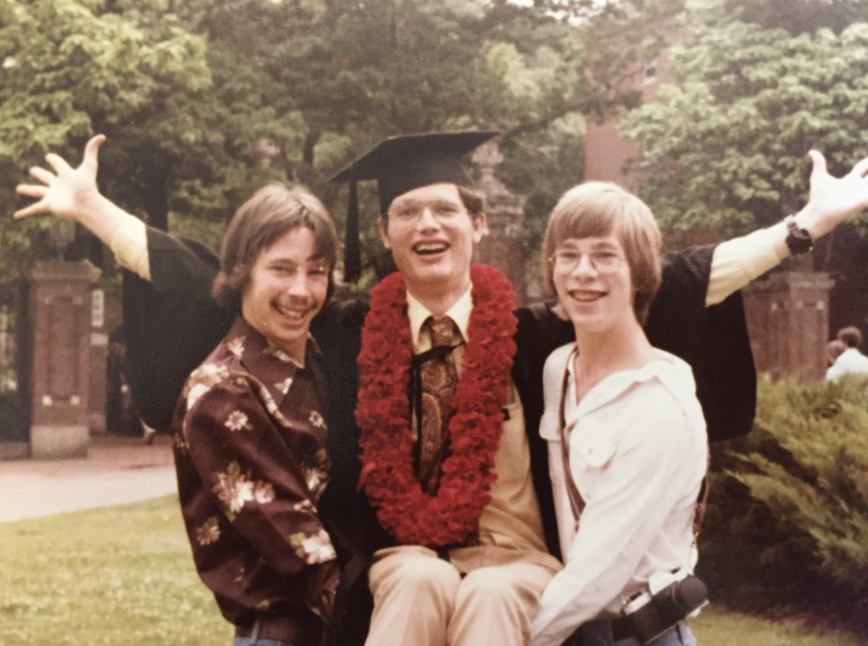
Dale Harvey Peterson
Last June, my friend and I found the door to a makeshift attic inside of Silliman College’s Grove Street tower. It was locked, but with a little jiggling of a plastic knife, my friend and I accessed the ladder and climbed up to the dark, hot, empty space. When we turned on our flashlights, we realized that we weren’t the first to enter: there was colorful graffiti, various class years and doodles painted on the beams, a warning that said “Watch ya head.” A lone chair sat in a corner, a crochet pillow with a unicorn tossed across the room. Then, underneath dust, insulation fluff, haphazardly placed wood planks and metal pipes, I found a scattered stack of letters, photos and documents, dated from 1968 to 1969.
More than half of the letters were written in German and some of the notes and envelopes had math equations scribbled on them. From the letters I could read, I noticed a few things: a mention of the moon landing, the Beatles, a call for an “open discussion” at Ingalls Rink with several signatures, ICYE (which I found out later to be the International Christian Youth Exchange), and the name Dale Harvey Peterson.
In this pile, there was a medium-sized brown envelope titled “Unfinished letters.” There were notes, questions, and index cards inside it, but one blue letter stood out. Unlike the other letters that touched on everyday events in Germany or in Sacramento, California, this letter read like one piece of a deep conversation: Dale admitted to a friend named Rick that he felt like Benjamin Braddock, the main protagonist from the 1967 movie “The Graduate.” “[I’m] learning all about many of the wonderful meaningless things I’ve done once in a while but cut off from meaningful contact with almost everyone…. I have no capacity for enthusiasm…. And of course I want, like Ben, [for] the future ‘to be different.’” I had no idea who Benjamin Braddock was, and I knew much less about Dale. I didn’t understand why these letters were hidden in Silliman. Were they abandoned? Or could they have been deliberately left as a sort of time capsule?

(Dale Harvey Peterson)
After tracking him down via Ancestry.com and a couple of university math department websites, I first spoke with Dale over Zoom on Aug. 4, 19 days before he turned 70. His dark-gray hair curled past his slightly asymmetrical ears and stubble covered his upper lip and his chin. He wore wide framed, black-rimmed glasses and a white shirt. Behind him stood colorful shelves filled with math books. He relies on Ethernet and he doesn’t have a cell phone. He spoke deeply and he erupted in laughter after saying a joke — or what seemed to be an obvious fact. In contrast to his 1968 letter to Rick, he had a warm, bubbly sense of humor.
Dale doesn’t know how the letters ended up in the tower. He doesn’t even remember writing them. “They have these little desks in your bedroom… and I could have just put them somewhere where I couldn’t see them or something…. Anyway, it’s not any big deal,” he said.
Instead, I learned more about him and how he got from the person in his letters to living alone in Vancouver, Canada. Dale grew up in a small, one-story home in Sacramento, California, near Mira Loma High School, with his older brother John and his younger brothers Burt and Marc. According to Burt, they had one car, got their hair cut at the local air force base for 25 cents, Mom sewed all their clothing and the curtains in the house, and she “always made dinner and had [it] ready for dad when he got home.” The Petersons seemed like a normal family, but they certainly weren’t: Dale was a “world-class mathematician.” In his sophomore year of high school, he scored the highest in the country through the Mathematical Association of America (a test “taken by more than 280,000 students”) and he was featured in the Sacramento Bee. During his undergraduate career at Yale, he mostly took graduate math courses. He completed his PhD dissertation at Harvard University in 1978 about the “Geometry of the Adjoint Representation of a Complex Semisimple Lie Algebra,” as a Putnam Fellow.
Over the next few years, he gave a series of 22 individual lectures at MIT. He even had a couple of concepts and theorems named after him, such as Peterson’s “Quantum equals Affine” theorem. “You take two totally different things, but they actually sort of intrinsically are really the same,” he explained. “That’s a very important thing. Usually has some deeper meaning.”
But Dale halted his work. “I intended to get [the lectures] all written up. It would have been 400 pages,” Dale said. “And I lost my concentration. There were a huge number of things I had to deal with.” He forgot about equations and ideas that he had written down. Sheafs of paper remained stacked, untouched and unpublished on desks. His early accomplishments drifted further back and his wallet shrunk. In 1986, he was offered a position at the University of British Columbia in Vancouver to teach as an associate professor in entry-level mathematics courses. He took it.
For 30 years, he never moved up the ranks. “In the opinion of the new chairman, I was not doing any research,” he wrote in an email. He was required to teach twice as many classes as most of his colleagues. Since he taught three morning classes a semester, he had to wake up at 4 a.m. five days a week, sleeping less than five hours a day for 15 of those years.
As much as Dale was devoted to thinking, reading, writing and lecturing about math and dwelling in questions about its infinite dimensions, the field wasn’t as patient: “The work I had done during the previous 10 years, amounting to a series of important discoveries comprising a greater whole, and my MIT lectures… counted for nothing.” Instead of a mathematician, he “became a ‘zombie…’ one who stumbled, who had to drive the same route each day to avoid getting lost, and who increasingly did not even understand the elementary mathematical courses he taught.”

(Dale in the middle with his two younger brothers Burt on the left and Marc on the right, 2014)
Wondering used to come naturally to Dale. Burt, Dale’s younger brother, recalled that late at night during the 1960s, while he was in high school, Dale would sit in his room, and he “would have these thoughts, these ideas, and he would write this stuff down.” About what specifically, Burt didn’t know. “He knows stuff in very disparate disciplines,” Burt said in awe. “He has a surprisingly good working knowledge of just an incredible breadth of topics.” Mathematics wasn’t a part of the world; it was a way to observe and analyze it.
And it didn’t matter where Dale was; he kept thinking. In his letter to Rick, Dale wrote about how a five-day trip in East and West Berlin was “a sharp stimulus to discuss and think — again — about very basic things which have been disturbing and stimulating me for the last two years,” including mathematical, political, philosophical and sociological issues: “Authority; a feeling of being caged in; Gulf between generations; School; Maturity; Art; Manipulation; where do I go from here; Tolerance; WAR.”
The only solution to these things that Dale could “imagine” was “the solution at the end, a union of two people, a solution for two people, but no solution for the society. But what comes in between?” The rest of this letter is left blank, unfinished.
In the same manner, Dale speaks as though he’s writing a letter, but only using commas, colons, and semicolons. In our conversations, he occasionally paused when new memories suddenly came into mind. He would close his eyes and try to remember certain details, or lick his lips between phrases and look away. What he gazed at, I don’t know. Maybe he was watching someone in his memory, a picture frame on top of his desk, an open notebook. There was no one behind him passing by, saying that it’s time for dinner; only the buzz of air conditioning.
He’s aware of the mind’s capacity to forget: “People feel as if their minds can live forever… but they don’t admit to themselves that their brains have gone downhill at all…. And so people actually fool themselves,” he said. He’s aware that he fools himself: “I still believe that I’m actually younger than I am.” As he spoke, fragments of memories intertwined with subjects like American politics in the ’60s, algae blooms, the Vietnam War, human motivations, aging, death and the cultural and philosophical differences amongst mathematicians and physicists all tied together in a single sentence without transitions. Everything was crammed in, almost as though there was always something more he wanted to say.
Although he says that he thinks in “terms of things that people actually know,” he’s confused by what motivates people, what influences their attitudes towards others. On our calls, he would often refer to others as “human beings” instead of “people.” Thirty minutes into our first Zoom call, he admitted, “I’m actually a person that doesn’t really know very much about other human beings.”
He’s not completely sure why. “Maybe I could be isolated in my life because I’m a mathematician” — he has numbers to factorize and calculate, new methods he must weave to replace the “lost thread” of his work that unraveled over the years. “The mathematical thing doesn’t change,” he told me, “but the mathematician does.”







